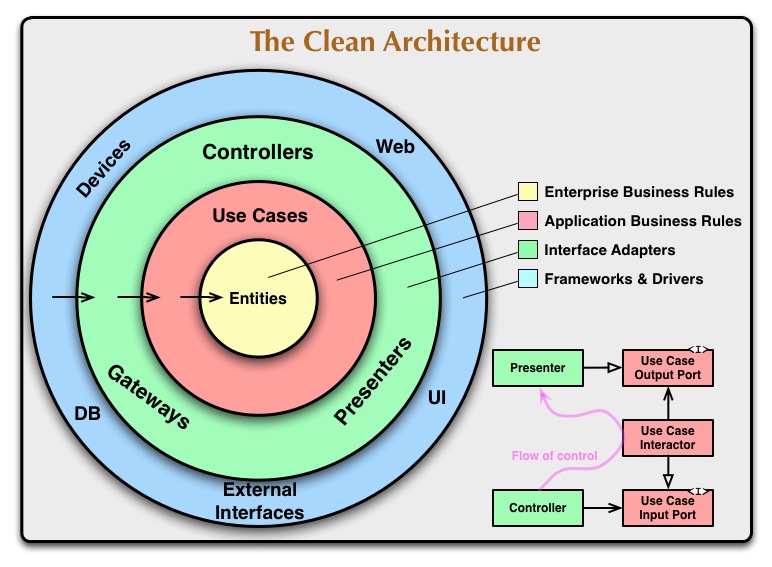The Clean Architecture in Python
@brandon_rhodes
PyCon Ireland
2013
The inspiration
Uncle Bob Martin’s
Clean Architecture
http://blog.8thlight.com/uncle-bob/2011/11/22/Clean-Architecture.html
http://blog.8thlight.com/uncle-bob/2012/08/13/the-clean-architecture.html

The pith
We programmers spontaneously
use subroutines backwards
subroutine
- Python function
- Python method
For how long have
programmers tended to use
subroutines backwards?
60 years
1952
ACM national meeting
Pittsburgh, Pennsylvania
THE USE OF SUB-ROUTINES IN PROGRAMMES
D. J. Wheeler
Cambridge & Illinois Universities
context
Typical computer:
1,000 words of RAM,
1,000 operations per second,
required a dozen people
How complex could programming
even be with only 1k of memory?
Wheeler (1952)
“the preparation of a
library sub-routine requires
a considerable amount of work
“However, even after it has
been coded and tested there still
remains the considerable task of writing
a description
so that people not acquainted
with the interior coding can
nevertheless use it easily.
“This last task may be the most difficult.”
What does Wheeler advertise
subroutines as being good at?
Hiding complexity
“All complexities should —
if possible — be buried
out of sight.”
Our mistake?
Our mistake
- Bury I/O
- Fail to bury anything else
import requests # Listing 1
from urllib import urlencode
def find_definition(word):
q = 'define ' + word
url = 'http://api.duckduckgo.com/?'
url += urlencode({'q': q, 'format': 'json'})
response = requests.get(url)
data = response.json()
definition = data[u'Definition']
if definition == u'':
raise ValueError('that is not a word')
return definition
def find_definition(word):
q = 'define ' + word
url = 'http://api.duckduckgo.com/?'
url += urlencode({'q': q, 'format': 'json'})
response = requests.get(url)
data = response.json()
definition = data[u'Definition']
if definition == u'':
raise ValueError('that is not a word')
return definition
def find_definition(word): # Listing 2
q = 'define ' + word
url = 'http://api.duckduckgo.com/?'
url += urlencode({'q': q, 'format': 'json'})
data = call_json_api(url)
definition = data[u'Definition']
if definition == u'':
raise ValueError('that is not a word')
return definition
def call_json_api(url):
response = requests.get(url)
data = response.json()
return data
def call_json_api(url):
response = requests.get(url)
data = response.json()
return data
Reusable
Isolates API knowledge
Single import requests
Isolates API knowledge
True story: that
code was initially
import json
...
response = requests.get(url)
text = response.text
data = json.loads(text)
def call_json_api(url):
response = requests.get(url)
data = response.json()
return data
Reusable
Isolates API knowledge
Single import requests
The fatal mistake
Stopping once the I/O has
disappeared into a subroutine
We privilege I/O by
granting it a subroutine,
leaving our logic stranded
and tightly coupled
Q:
We have hidden I/O,
but have we really
decoupled it?
Pace Wheeler,
hiding is not enough
def find_definition(word): # Listing 2
q = 'define ' + word
url = 'http://api.duckduckgo.com/?'
url += urlencode({'q': q, 'format': 'json'})
data = call_json_api(url)
definition = data[u'Definition']
if definition == u'':
raise ValueError('that is not a word')
return definition
def call_json_api(url):
response = requests.get(url)
data = response.json()
return data
def find_definition(word): # Listing 3
url = build_url(word)
data = call_json_api(url)
return pluck_definition(data)
def build_url(word):
q = 'define ' + word
url = 'http://api.duckduckgo.com/?'
url += urlencode({'q': q, 'format': 'json'})
return url
def pluck_definition(data):
definition = data[u'Definition']
if definition == u'':
raise ValueError('that is not a word')
return definition
Claim
Listing 3 is an architectural success
while the others were failures
Listing 3 shows in miniature what
the Clean Architecture does
for entire applications
def find_definition(word): # Listing 3
url = build_url(word)
data = call_json_api(url)
return pluck_definition(data)
The coupling between
logic and I/O is isolated
to a small procedure
def find_definition(word): # Listing 3
url = build_url(word)
data = call_json_api(url)
return pluck_definition(data)
Eminently readable
because it remains at a
single level of abstraction
def find_definition(word): # Listing 3
url = build_url(word)
data = call_json_api(url)
return pluck_definition(data)
These names document
what each section
of code is doing
XP
# Build the URL
q = 'define ' + word
url = 'http://api.duckduckgo.com/?'
url += urlencode({'q': q, 'format': 'json'})
Replace comments with names:
def build_url(word):
q = 'define ' + word
url = 'http://api.duckduckgo.com/?'
url += urlencode({'q': q, 'format': 'json'})
Our Architecture
Listing 1
↘
procedure
Listing 2
↘
procedure
↘
i/o procedure
Listing 3
↘
procedure
↘
pure function
↘
i/o procedure
↘
pure function
Testing
How would we have
tested listing 1 or 2?
Goal
Test the code without
calling Duck Duck Go
Two techniques
- Dependency injection
- With mock.patch()
Dependency injection
2004 — Martin Fowler
Make the I/O library
itself a parameter
import requests
def find_definition(word, requests=requests):
q = 'define ' + word
url = 'http://api.duckduckgo.com/?'
url += urlencode({'q': q, 'format': 'json'})
response = requests.get(url)
data = response.json()
definition = data[u'Definition']
if definition == u'':
raise ValueError('that is not a word')
return definition
class FakeRequestsLibrary(object):
def get(self, url):
self.url = url
return self
def json(self):
return self.data
def test_find_definition():
fake = FakeRequestsLibrary()
fake.data = {u'Definition': 'abc'}
definition = find_definition(
'testword', requests=fake)
assert definition == 'abc'
assert fake.url == (
'http://api.duckduckgo.com/'
'?q=define+testword&format=json')
Problems
- Your mock is not the real library
- This might look simple for one service
But a procedure that also
needs a database and filesystem
will need lots of injection
A high-level function
needs every single service
required by its subroutines
↘
big_procedure(web=web, db=db, fs=fs)
↘
smaller_procedure(web=web, db=db)
↘
little_helper(web=web)
A dynamic language like
Python has ways around
dependency injection
from mock import patch
def test_find_definition():
fake = FakeRequestsLibrary()
fake.data = {u'Definition': u'abc'}
with patch('requests.get', fake.get):
definition = find_definition('testword')
assert definition == 'abc'
assert fake.url == (
'http://api.duckduckgo.com/'
'?q=define+testword&format=json')
DI or patch()
Either way,
awkward
sad
How does testing improve
when we factor out our
logic as in Listing 3?
def find_definition(word): # Listing 3
url = build_url(word)
data = call_json_api(url)
return pluck_definition(data)
def build_url(word):
q = 'define ' + word
url = 'http://api.duckduckgo.com/?'
url += urlencode({'q': q, 'format': 'json'})
return url
def pluck_definition(data):
definition = data[u'Definition']
if definition == u'':
raise ValueError('that is not a word')
return definition
By definition, pure functions
can be tested using only data
def test_build_url():
assert build_url('word') == (
'http://api.duckduckgo.com/'
'?q=define+word&format=json')
def test_build_url_with_punctuation():
assert build_url('what?!') == (
'http://api.duckduckgo.com/'
'?q=define+what%3F%21&format=json')
def test_build_url_with_hyphen():
assert build_url('hyphen-ate') == (
'http://api.duckduckgo.com/'
'?q=define+hyphen-ate&format=json')
- No special set-up
- No special preparation
- Test calls are symmetricwith normal calls
import pytest
def test_pluck_definition():
assert pluck_definition(
{u'Definition': u'something'}
) == 'something'
def test_pluck_definition_missing():
with pytest.raises(ValueError):
pluck_definition(
{u'Definition': u''}
)
A symptom of coupling
call_test(good_url, good_data)
call_test(bad_url1, whatever)
call_test(bad_url2, whatever)
call_test(bad_url3, whatever)
call_test(good_url, bad_data1)
call_test(good_url, bad_data2)
call_test(good_url, bad_data3)
So let’s talk architecture

“In general, the further in you go,
the higher level the software becomes.
The outer circles are mechanisms.
The inner circles are policies.”
“The important thing is
that isolated, simple data structures
are passed across the boundaries.”
“When any of the external parts
of the system become obsolete, like
the database, or the web framework,
you can replace those obsolete elements
with a minimum of fuss.

def find_definition(word): # Listing 3
url = build_url(word)
data = call_json_api(url)
return pluck_definition(data)
def build_url(word):
q = 'define ' + word
url = 'http://api.duckduckgo.com/?'
url += urlencode({'q': q, 'format': 'json'})
return url
def pluck_definition(data):
definition = data[u'Definition']
if definition == u'':
raise ValueError('that is not a word')
return definition
How do you test the
top-level “procedural glue”?
Gary Bernhardt
PyCon talks:
- Units Need Testing Too
- Fast Test, Slow Test
- Boundaries
“Imperative shell”
that wraps and uses your
“functional core”
Functional core — Many fast unit tests
Imperative shell — Few integration tests
This should only require
one or two integration tests!
def find_definition(word): # Listing 3
url = build_url(word)
data = call_json_api(url)
return pluck_definition(data)
Functional programming
LISP, Haskell, Clojure, F#
Functional languages naturally
lead you to process data structures
while avoiding side-effect I/O
# I/O as a side effect
def uppercase_words(wordlist):
for word in wordlist:
word = word.upper()
print word
# Logic with zero side-effects
def process_words(wordlist):
return [word.upper() for word in wordlist]
# I/O goes outside of logic
def procedural_glue(wordlist):
upperlist = process_words(wordlist)
for word in upperlist:
print word
Procedural code:
Output as-you-go
Functional code:
Each stage produces a data structure,
that gets output at the end
Engineering students
will tell you that Statics class
is easier than Dynamics class
Why functional?
Because of immutability?
My guess
The biggest advantage of data in
a functional programming style
is not its immutability
It is simply the fact
that it is data!

Fred Brooks
1975
“The bearing of a child
takes nine months, no matter
how many women are assigned.”
“Show me your flowchart and
conceal your tables, and I shall
continue to be mystified.
Show me your tables, and I won’t
usually need your flowchart;
it’ll be obvious.”
1986
McIlroy vs. Knuth

Knuth — Literate programming
“Given a text file and an integer k,
print the k most common words in the file
(and the number of their occurrences)
in decreasing frequency.”
Knuth: 10 pages of Pascal
McIlroy:
“Knuth’s solution is to tally in an
associative data structure each word
as it is read from the file.
“The data structure is a trie, with 26-way
(for technical reasons actually 27-way)
fan-out at each letter. To avoid wasting
space all the (sparse) 26-element arrays
are cleverly interleaved in one common
arena, with hashing used to assign homes”
McIlroy: 6-line shell script
tr -cs A-Za-z '\n' |
tr A-Z a-z |
sort |
uniq -c |
sort -rn |
sed ${1}q
“Every one was written first
for a particular need, but untangled
from the specific application.”
Traditional lesson:
Use small simple tools that
can easily be linked together
Python!
- Lists
- Dictionaries
- Comprehensions
- Generator functions
- Generator expressions
- For loops
But I want to draw
a different lesson:
The shell script is simpler
because it operates through the
stepwise transformation of data
tr -cs A-Za-z '\n' |
tr A-Z a-z |
sort |
uniq -c |
sort -rn |
sed ${1}q
This approach continually surfaces
intermediate results using a magnificent
data structure: plain-text lines
tr -cs A-Za-z '\n' |
tr A-Z a-z |
sort |
uniq -c |
sort -rn |
sed ${1}q
So why immutability?
Gary Bernhardt:
distributed computing
See Jonathan Harrington’s
“The Data Storm” talk from
the previous session here
at PyCon Ireland
Data and transforms are easier
to understand and maintain
than coupled procedures
If that is the case,
then Python has been evolving
in exactly the right direction
for i in range(len(items)):
item[i] = transform(item[i])
Python 2.0 (October 2000)
↓
items = [tranform(item) for item in items]
items = list(load_items())
items.sort()
for item in items:
...
Python 2.4 (November 2004)
↓
for item in sorted(items):
..
Remember: Python has several kinds
of callable beyond plain sub-routines!
- generators
- context managers
generators
Imagine a compound iteration that
occurs repeatedly through your code
for college in university.colleges:
for school in college.schools:
for department in school.departments:
...
def all_departments(college):
for college in university.colleges:
for school in college.schools:
for department in school.departments:
yield department
def process1():
...
for department in all_departments(college):
....
def process2():
...
names = [department.name for department
in all_departments(college)]
....
context managers
r = get_resource()
r.get_ready()
try:
use(r)
finally:
r.close()
with get_resource() as r:
use(r)
Two real-world examples
- Skyfield
- Luca
Skyfield
Object-based API backed by
dozens of pure functions that
implement the actual operations
The miserable thing about a
method is that it implicitly depends
upon the state of the whole object
The beautiful thing about a
function is that it explicitly depends
upon a specific list of arguments
>>> import this
The Zen of Python, by Tim Peters
Beautiful is better than ugly.
Explicit is better than implicit.
...
Luca
Temptation
Compute output fields as
the form is running, writing
their text into the PDF
Instead: phases
First read the entire tax form
Then do all the computations
Finally write to the PDF
Luca’s approach of processing a
form in phases made an unexpected
improvement in my tracebacks!
A → B → C → D
Coupled procedures:
Very deep tracebacks
when D raises exceptions
B
↗↙
A ←→ C
↘↖
D
Decoupled functions:
Get shallow tracebacks,
only a few frames high
The pith
Old
To get rid of I/O,
make it subordinate
New
To really get rid of someone,
make them a manager!
Let’s return to Wheeler
In 1952 he gave us the “sub-routine”
We have yet to realize
its full power and promise!
“When a programme has been
made from a set of sub-routines the
breakdown of the code is more complete
than it otherwise would be.
“This allows the coder
to concentrate on one section
of the program at a time without
the overall detailed programme
continually intruding.
“Thus the sub-routines
can be more easily coded and
be tested in isolation from the
rest of the programme.
“When the entire programme
has to be tested it is with the
foreknowledge that the incidence
of mistakes in the subroutine is —
zero
“(or at least one order
of magnitude below that of the
untested portions of the programme!)”
☘
@brandon_rhodes